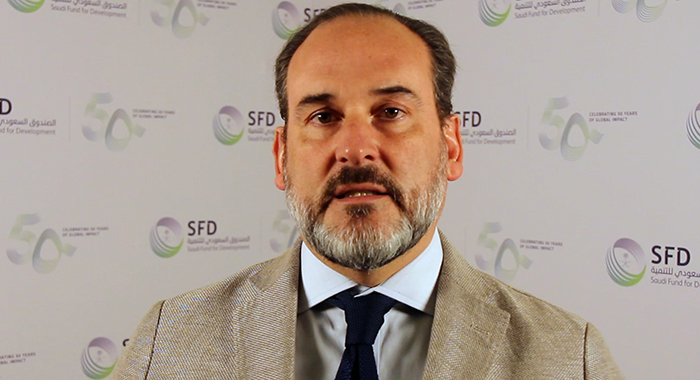By Kenton X. Chance,
RIYADH, Saudi Arabia (CMC) — A senior official of the Latin American and Caribbean Development Bank (CAF), Ignacio Coronazole Hughes, says it intends to play a greater role in the socio-economic development of the Caribbean and is moving to expand its presence in the region.
CAF is a development bank owned by 19 countries including 17 in Latin America and the Caribbean, Spain and Portugal as well as 13 private banks in the region.
Its headquarters is in Venezuela with offices in Buenos Aires, La Paz, Brasilia, Bogota, Quito, Madrid, Mexico D.F, Panama City, Asuncion, Lima, Montevideo and Port of Spain.
CAF’s Manager for Resource Mobilization and Global Alliance, Ignacio Corlazzoli Hughes, told the Caribbean Media Corporation (CMC) that CAF recently changed its name to include Latin America and the Caribbean Development Bank.
“We just did that in April, when three countries from the Caribbean joined the bank. So now we have six countries. We had Trinidad and Tobago who joined us like 30 years ago, along with Jamaica.
“We had Barbados who joined later on and a couple of months ago, we had The Bahamas, Dominica and Grenada who just joined the bank,” he said, noting that CAF’s president, Sergio Díaz-Granados is an attorney from Colombia, who has this very broad Caribbean perspective.
“And while we are expanding the mandate of the bank to become the blue and green development bank of the region, we are also expanding our geographic scope. And President Diaz-Granados is planning to transform CAF into the bank that has the most active member countries, and we are expanding and reaching out to many more Caribbean countries,” said Corlazzoli Hughes, who is here attending the 50th anniversary of the Saudi Fund for Development (SFD).
“So we hope that in the very near future, by next year, we are going to become the bank with the most countries in the region.”
Corlazzoli Hughes said that while CAF is unlike other banks in the region with a significant majority of its capital coming from within the region, he is aware of the challenges and opportunities for developmental finance in the Caribbean region.
“… we don’t have a difference between borrowing and non-borrowing member countries. So 95% of capital is from the region. We have Portugal and Spain with 5%, but we are a bank that can allow borrowing to every member country. That’s very important.
“So within our structure, the way our board is conceived, our board of ministers, we don’t have a sitting board, unlike other banks. the way, the think is that we are very close to our clients.”
He said given the mandate of the CAF president that the financial institution to be very much an infrastructure bank moving towards the blue and green bank of the region “we are actively working on climate change.
“In that sense, we have a mandate that we need to … make 30% of our approvals in climate change operations. We have to transform our modality, the way we think, the way we approve, operation, the way we work, precisely to have a bigger and better and stronger impact on climate change operations in the Caribbean.
“For example, we just finance … the new Bank for Development in Jamaica, the blue and green one. We are actively involved in the Bridgetown Agenda that’s led by Prime Minister Mia Mottley of Barbados.
“We are trying to seek what we do, for example, in Trinidad and Tobago in a more sustainable way, on infrastructural project. We are actively now working in Trinidad thanks to other partners, such as the European Commission … but we’re always thinking about the impact and the sustainable impact these have on the citizens.
“What we want to do is to improve their lives, and in this way, trying to be much closer to the Caribbean citizens,” Corlazzoli Hughes said, explaining the efforts towards moving to a blue and green bank.
“So the way we want to work on the blue and green bank … for example, in the Caribbean, you have up to 10% of the worldwide coral reef, if I am not mistaken, much of which, unfortunately, is bleaching.
“We are going to be working more on those solutions, nature-based solutions, working with the ocean, the blue economy,” Corlazzoli Hughes told CMC.
“We made a commitment a few years ago back … to increase our financing for the blue economy. At the same time, we are working on climate change issues. We want to become the voice of the region, the financial voice of the region, especially of the Caribbean region, on climate change discussions.”
Corlazzoli Hughes said in order to protect CAF is to become a bridge between Latin America and the Caribbean.
“These two regions, while in the same geography, have been working back to back, unfortunately, over the last few years, and we want to position CAF as that bridge where we can reproduce lessons learned from one region to the other and to try to work on a more integrated way.
“Because, as you might know, when you have a hurricane that impacts, it doesn’t impact one country. It impacts the entire Caribbean. It impacts the entire region. It does not, I mean, limit itself to the English, to Spanish, or to the French countries. It goes in the entire region, hitting Venezuela, Colombia, Mexico, and even the US, along with the Caribbean.
“So what we are trying to do at CAF is trying to start to work on a bigger scheme, and not limiting ourselves to our borrowing countries, to our member countries, but try to see the Caribbean, per se, as the whole basin. I think that’s what President Diaz-Granados is trying to aim for the Caribbean,” Corlazzoli Hughes told CMC.
Caribbean efforts praised
He acknowledged that the Caribbean faces an uphill task in getting the international community to respond to climate change mitigation, adaptation and rebuilding after natural hazards.
“I would like to start by praising what the Caribbean countries have been doing macro-wise, over the last 10 years. As we all know, Caribbean economies are highly indebted,” he said, noting that even though the region has reached pre-pandemic percentage, the rate of debt per gross domestic product (GDP) “was, I believe, before the pandemic was around 75%.
“it went up way up during the pandemic, for many reasons, because of public investment, because of lack of tourism revenues. And now we are back to, I think it’s 77% and that’s mostly, firstly, because of Guyana’s growth. I mean, unbelievable growth. And on what Jamaica has been doing on this very strict and praiseable measure…
“Those are two countries. But I think we have to recognise that what the Caribbean has been doing is better management of the debt, and of course, when increasing their revenues and strengthening some institutions, some fiscal institutions, that’s one”
Corlazzoli Hughes said that debt gives countries “a very limited fiscal space to what you can do,” noting that “in the Caribbean, I would say two out of 10 most worldwide countries have been the most severely affected by many climate change disasters such as Haiti, such as Bahamas, every time you hit by a hurricane, a huge percentage of your GDP is back in question.
“So there’s only so much countries can do. Why? Because the International Monetary Fund (IMF) and others limit your spending — your public spending.
“So we are working together. And, for example, we have been listening to what the Bridgetown agenda, and we are trying to work on new financial instruments for the region.
Many countries have been working in the Caribbean on insurance schemes for the whole region.
“CAF is building, is being part of the solution. We were recently approved for use of SDRs (Special Drawing Rights) at the IMF. Those are resources that could be used, for example, for climate change schemes in the Caribbean.
“CAF is available for you. For use of those, we are trying to find new financial schemes with new financial partners. For example, precisely SFD. SFD provides grants,” Corlazzoli Hughes told CMC.
“Why are these grants so important? First thing, I mean, they have a limited amount, but these grants are important because when you add those grants to our loans, for example, you reduce the debt.
“I mean not only the amount of debt, but you reduce the rate of the debt and that’s important for the country, but most important, it also allows you to bring innovative financial instruments,” he added.
“For example, you have a major problem with the sargassum in the region. That’s going to impact tourism. Sargassum is not a limited country perspective. There’s no response country per country. It has to be considered as a regional problem, as a regional issue.
“What can we do on a regional level for the sargassum? So I know you have a conference ahead, I believe, in the month of October, for the entire Caribbean, sponsored by the European Commission. We are going to be actively involved in that one.
“This is the kind of innovative instrument that we are trying to do for the Caribbean,” Corlazzoli Hughes told CMC.







Let me make it short for you! They are coming for the kill, as simple as that. They are the ones who created the problems so as to enslave you.
The vultures are circling; and growing in numbers.
headline…..is it LAC or should it be LAF? Just asking.
If God don’t intervene I don’t know what will happen to SVG